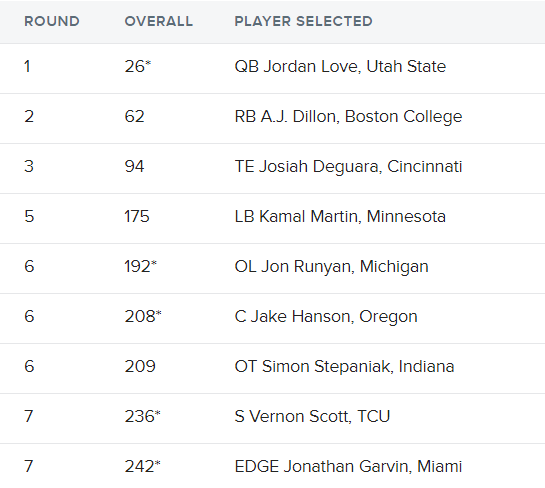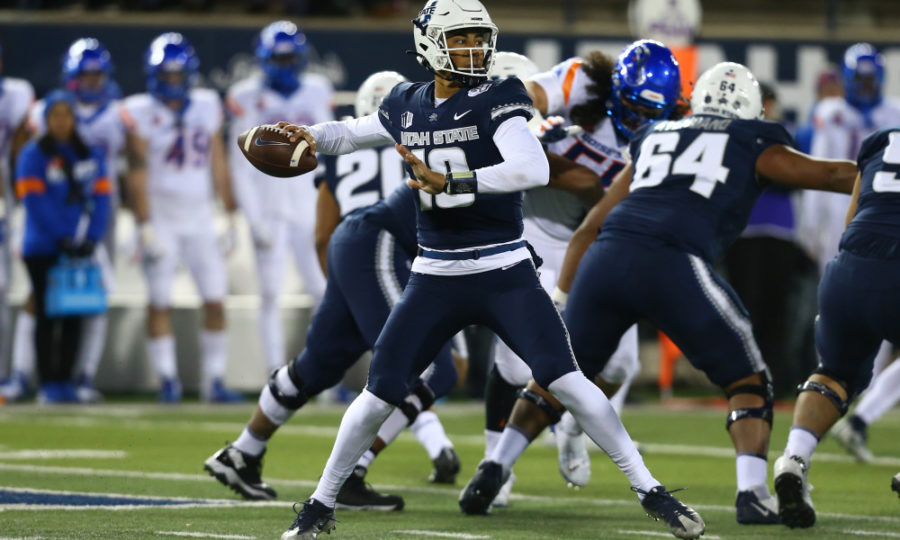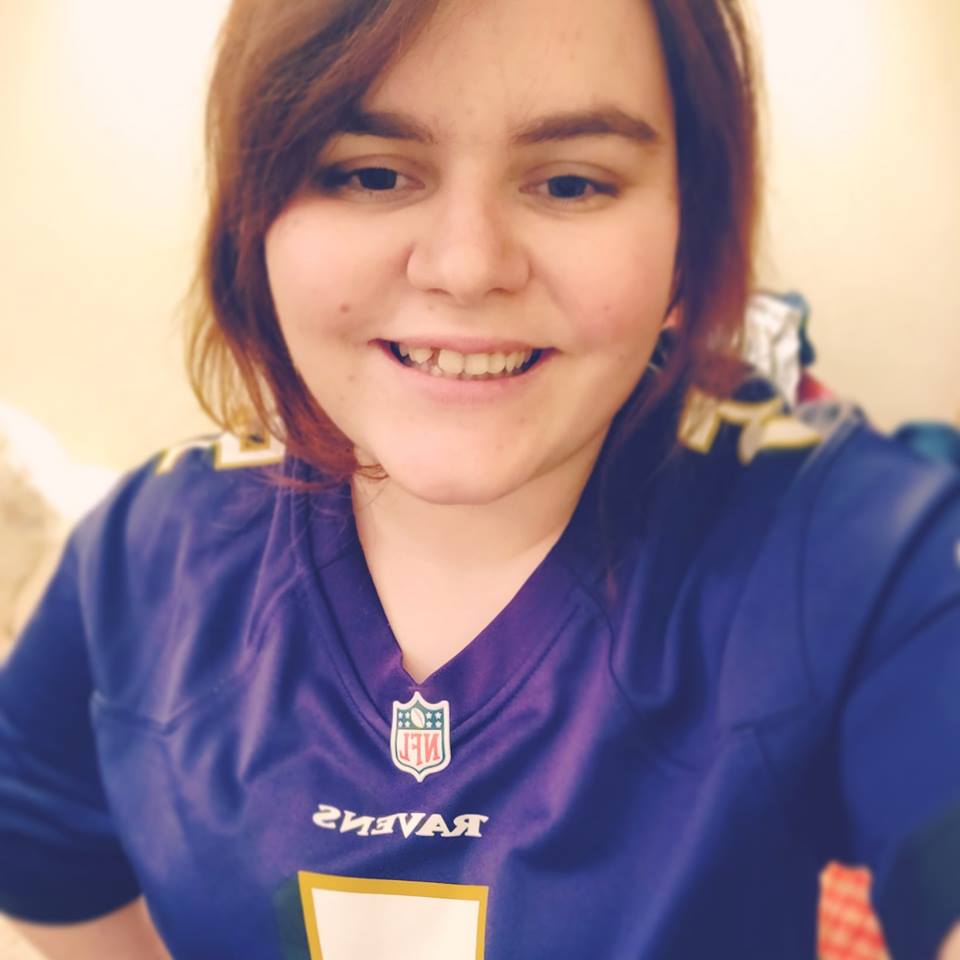Are the Green Bay Packers Unable or Unwilling to help Aaron Rodgers?
The 2020 NFL Draft brought with it a lot of head scratching for fans of the Green Bay Packers. With everyone expecting the Packers to add some reliable talent for Aaron Rodgers to throw the ball too, they pivoted and took the team in a completely different directions. The question for many is whether this was a strategy by the Packers front office, meaning they are simply unwilling to give Rodgers help, or if the circumstances of the draft forced their hand in taking the course they did over the three nights of the 2020 NFL Draft?
We will most likely never truly know the answer to that question. However, what we can do is look back over the recent history of the Packers in the draft and see what trends emerge, as well as determining if the strategy they have been taken has been successful.
The 2019 season
In 2019, the Green Bay Packers managed to reach the NFC Championship, following a season that saw them emerge first in the NFC North, with a stellar 13-3 record. The ingredients of their success are split three – ways: their quarterback, their running corps and their pass defense. Aaron Rodgers, at age 36, was still incredibly efficient, totaling 4.002 yards, 26 touchdowns and only 4 interceptions. Running back Aaron Jones also shone brightly, boasting an NFL leading 16 rushing touchdowns, with 1.084 yards on the ground. The Smith duo of Preston and Za’Darius was a menace on the front seven, recording 25.5 sacks in total, establishing the defense as one of the best against the pass.
In the NFC Championship Game, however, their weaknesses would be showcased for all to see; an ineffective run defense would leave the Packers to the mercy of 49ers’ running back, Raheem Mostert, who rushed for 4 touchdowns and 220 yards, both playoff records. Lack of receiving weapons would also handicap Rodgers, as one of his two touchdowns was caught by his running back, Aaron Jones.
Thus, another chance for the Packers to participate in the Super Bowl was thrown away, and the culprit was well known. 32.5% of Rodgers’ 26 passing touchdowns, last season, were thrown to running backs. The remaining were passed along 5 different receivers and three tight ends, and only 3 of these eight targets (WR Davante Adams, TE Jimmy Graham, RB Aaron Jones) were starting players. Out of the three tight ends, two were above the age of 32.
We’ve seen Rodgers, time and again, pulling out the best from receivers that, arguably, wouldn’t have flourished anywhere else. This year, his magic didn’t help matters when his various targets accumulated for 658 yards on dropped passes. To put the number into perspective, the league average of yards on dropped passes last year was 282 yards.
Aaron Rodgers' receivers cost him at least 648 yards last season because of drops. The average for qualifying quarterbacks was 282 and the second-placed quarterback had only 507. pic.twitter.com/UCkG2iYXpM
— QB Data Mine (@QBDataMine) April 19, 2020
A head scratching strategy in Green Bay
In 2018, Rodgers signed a four year, $134 million contract, which offered a $57.5 million signing bonus and $98.7 million in guaranteed money, essentially keeping him in Green Bay until, at least, 2022. Should they choose not to re-sign him, it will still cost them quite a buck, as they’ll have up to $17,204,000 in dead cap. Given the facts above, it’s logical that Green Bay would follow in the footsteps of franchises like the Los Angeles Rams and the San Francisco 49ers, where they prefer to support their luxuriously paid quarterbacks with rookie contracts from draftees. Serendipitously, this year’s Draft was ideal for such plans, where receivers were available almost in abundance.
And the Packers drafted the following players:

Before commenting on one of the most head scratching drafts many have seen in years, it is worth emphasising Green Bay’s previous drafts, specifically from 2014 and onward. Why 2014? Well that was the last season that many gave the Packers had any realistic hopes for a Super Bowl, where they met their end at the hands of the Seattle Seahawks. In 2016, even though they reached the NFC Championship again, they had played their trump cards in the Divisional round against the Dallas Cowboys, a game that, if you remember, was won in the trenches due to a fantastic performance by Aaron Rodgers. Many never expected them to beat the ferocious Atlanta Falcons of that year, and it proved to be correct.
Back to the draft classes since 2014, where the Packers have had five drafts, and in those drafts, they have chosen the following receivers and tight ends:
- Ty Montgomery, #94th pick (drafted as a WR, turned into a RB shortly after)
- Kennard Backman, #213th pick (played in only 7 games)
- DeAngelo Yancey, #175th pick (never progressed past the practice squad)
- Malachi Dupre, #247th pick (played in only one game)
- J’Lon Moore, #133th pick (played in 75% of one season)
- Marquez Valdes – Scantling, #174th pick (the only one who lasted, took on the WR2 role, and has arguably produced in lieu of Rodgers being his QB)
- Equanimeous St. Brown, 207th pick (suffered an injury in 2019)
- Jace Sternberger (played in only six games as a rookie)
What about the talent Rodgers did play with?
Some will argue that Rodgers already had adequate weapons, in the faces of Jordy Nelson and Davante Adams. You have to remember, though, that Nelson’s last good season was in 2016, and he was already 31 years old then. It’d make sense for the Packers to start searching his replacement. Instead, they went along with Davante Adams, who is, admittedly, a phenomenal route runner. Apart from these two, Rodgers has been producing with an ever revolving cast, featuring names from Richard Rodgers to Jared Cook, and Randall Cobb to James Jones, and I am sure I can argue that two of them only augmented their performance thanks to Rodgers’ prowess. A prowess which has visibly deteriorated, if we take into account the declining stats of Rodgers’ performance throughout the years.

Comparisons tend to highlight details you wouldn’t otherwise notice, so allow me to show the difference of the Packers to the 49ers and Chiefs, last year’s Super Bowl participants. Keep in mind that while Patrick Mahomes is still on his rookie contract, Jimmy Garoppolo’s doesn’t differ much from Rodgers’. From 2015 to 2020, the 49ers and the Chiefs have drafted 6 receivers (2 for KC, 4 for SF) in rounds 1 – 3 of the draft, they have given to four receivers (2 for KC, 2 for SF) contracts of $5 or more million, and they have signed 10 receivers (6 for KC, 4 for SF) at the peak of their careers. The Packers tally the spectacular amount of zero receivers in any of these categories.
Where have the Packers focused their attention instead?
Going back to the previous drafts, one could argue that most picks were used for the reinforcement of the defense or the offensive line. It wouldn’t be an outrageous line of thought, as 5 picks were used for offensive linemen and an impressive 22 for defensive players between the 2015 – 2019 drafts. Out of all those picks, only three stand out for me; DT Kenny Clark, CB Jaire Alexander and CB Josh Jackson, and the verdict is still out for the latter two, as they were chosen in 2018, and haven’t had the time to acclimatise properly in the professional level.
As for the rest of the defensive picks? Did they really help bolster a defense that hadn’t seen good days since Charles Woodson was a Packer? The answer may disappoint you. On average, Green Bay’s defense has fared thusly in the major defensive stats, from 2015 to 2019:
Points against: 18th (below the top 20 for 3 straight years)
Yards against: 19th
Takeaways: 17th (30th in 2018)
Total (pass + rush) 1st downs: 17th (28th in 2017)
Penalties: 12th
The word you are looking for to describe their defence is mediocre. Teams like the Rams or 49ers picked a defensive player that helped turn their franchise around. The Packers never managed to find a valid substitute for either Clay Matthews III or the aforementioned Charles Woodson.
The Packers' 2019 draft class

Which brings us to this year’s Draft. A draft in which the Packers opted to spend their first two picks on a quarterback and a running back, two positions they hardly needed first and second round picks for. In the case of QB Jordan Love, the Packers actually traded up to acquire him, over the Miami Dolphins, the Seattle Seahawks, the Baltimore Ravens and the Minnesota Vikings; teams that hardly needed a quarterback. Green Bay then proceeded to utilise their following seven picks by selecting only one tight end, no receivers and defensive players that weren’t even the best selections available.
It is still baffling on how they let EDGE Bradley Anae fall to the Cowboys while they picked LB Kamal Martin, who struggles in tackles and is not overly athletic (who’s going to stop Mostert again?). Look no further than the Indianapolis Colts or the Tampa Bay Buccaneers, two franchises with older QBs than Rodgers, and how they planned around them and went for offensive linemen and skill position players. Or, even, the Baltimore Ravens and San Francisco 49ers, who were efficient and focused on immediately replacing players in positions of need that were recently vacated.
In total, 27 receivers were taken in the first two rounds, and the Packers selected a quarterback and a running back. There have been a number of counterarguments as to why the Packers’ draft wasn’t so peculiar, but let’s focus comment on the two most common replies.
Every team has to look into the future. Isn’t it logical for the Packers to be searching, already, for Rodgers’ heir apparent?
No. Not at this point in time. The 2020 NFL Draft was one that had a multitude of receivers to choose from, so many that even teams that didn’t actually need one actually got them (like Dallas with CeeDee Lamb). You have a team with a quarterback that reached the NFC Championship, and has at least three years ahead of him. The logical thing is to enter in a win now mode and try to surround your quarterback with players that he has visibly missed for some time now. They won’t get rid of Rodgers anytime soon, not unless a team is willing to shoulder his massive contract. To make matters worse, Brian Gutekunst himself admitted that Love is a raw project that needs time to establish himself as ready for the pro level. They spent their first round pick on a player that, bar incident, won’t see the field until 2023.
Didn’t the same scenario unfold when Rodgers was selected to succeed Brett Favre? Why is it so inane now?
First things first, Favre was 35 years old in 2005, and had already passed through a collection of injuries, as he played in times where quarterbacks were way less protected. Rumours of his imminent retirement were circulating around the media a lot during that off season, and even Favre himself seemed to contemplate it. Plus, when Rodgers was selected, the team wasn’t in such a dire need of offensive players.
The most important thing, however, was that Rodgers was on a different level to what Love is now. He was a top prospect, a locked first overall pick for many analysts. There were debates on whether he or Utah’s Alex Smith were going to go first, and even when Rodgers didn’t, no one expected him to drop past the tenth pick. He dropped all the way down to 24. If the Packers had, this year, selected a quarterback with the same credentials as Rodgers had back in 2005, it would have still seemed nonsensical. As it is, Green Bay traded up for a quarterback that was projected as a second rounder, or a late first to a very desperate team. They have risked potentially sacrificing their short-term future for a project player who may not even translate into long-term success.
This may seem harsh, but how long are Packers fans supposed to wait for the franchise to utilise the full extent of Rodgers’ talent? A talent which hasn’t begun to decline at the rate many are suggesting and a player who should continue to perform for the foreseeable future. The hope was that Gutekunst’s arrival would mark a new beginning in Green Bay, where certain, often maligned, positions would be infused with young, aspiring talent. Instead, none of the immediate needs were correctly sorted.
One can only wonder if it’s a Packers curse, not being able to help their quarterbacks in the years after they’ve won a Super Bowl. After all, it took 14 years to win it all again after their success in Super Bowl XXXI.
Image credit: Jake Roth-USA TODAY Sports & Brian Losness-USA TODAY Sports

